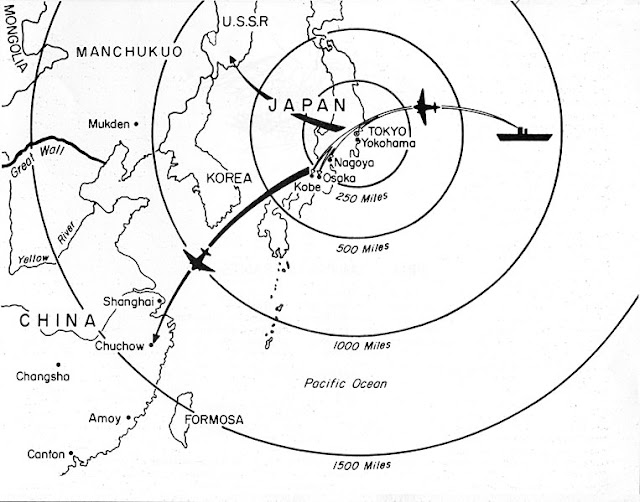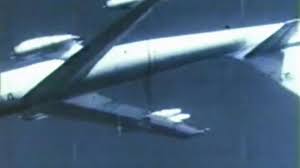RetroWARTHINK 025: Doolittle's Raiders with B-25B SeaMitchell Seaplanes
In a video on the Bermuda Triangle Flight 19 mystery, we proposed that the 5x TBF/M Avengers could have been SEAPLANES and put down intact on the water and became defacto boats signalling for rescue by a mere addition of an under-fuselage boat-shape with step addition and fold-down wing floats. I didn't express this "Semi-Seaplane" concept well lacking a drawing.
https://www.bitchute.com/video/LWTwwh0CPplt/
Here's
TRY #2 (YES, Yoda there is a TRY).
Semi-Seaplane
means an EMERGENCY water landing capability rendering the aircraft into a
defacto life boat--NOT a full seaplane you could land and take-off by choice.
IMHO ALL aircraft carrier planes should be at least semi-seaplanes with zero
drag penalty PANTOBASE SKIS like the Convair SeaDart and YC-123
demonstrator demonstrated coupled with a watertight rest of the airplane.
www.combatreform.org/seaplanetransports.htm
https://www.youtube.com/watch?v=678GOHdL-O0
Here is a
B-25B SeaMitchell with a moderately draggy boat hull bottom and
protrusions under each engine nacelle that came to mind watching the horribly
titled movie "In Harm's Way" [already a superb John Wayne
movie by this name] CGI depicting Colonel Doolittle's Raiders running out of
gas unlike Bugs Bunny and crash-landing or parachute bailing out; then doing
the escape & evasion drill resulting in Japanese reprisals upon the hapless
Chinese citizens.
https://en.wikipedia.org/wiki/Doolittle_Raid
The
concept for the attack came from Navy Captain Francis S. Low, Assistant Chief
of Staff for antisubmarine warfare. He reported to Admiral Ernest J. King on 10
January 1942 that he thought that twin-engined Army bombers could be launched
from an aircraft carrier, after observing several at Naval Station Norfolk
Chambers Field in Norfolk, Virginia, where the runway was painted with the
outline of a carrier deck for landing practice.[9]
Sixteen B-25B Mitchell medium bombers were launched without fighter escort from the U.S. Navy's aircraft carrier USS Hornet in the Western Pacific Ocean, each with a crew of five men. The plan was to bomb military targets in Japan and to continue westward to land in China. The bombing raid killed about 50 people, including civilians, and injured 400. Fifteen aircraft reached China, all of which crashed, while the 16th landed at Vladivostok in the Soviet Union. Of the 80 crew members, 77 survived the mission. Eight airmen were captured by Imperial Japanese Army troops in Eastern China, of whom three were later executed. The B-25 that landed in the Soviet Union was confiscated and its crew interned for more than a year before being allowed to "escape" via Anglo-Soviet-occupied Iran with the help of the NKVD. Fourteen complete crews of five returned to the United States or to American forces, except for one crewman who was killed in action.[4][5]
The raid
caused little damage to Japan, but had major psychological effects. In
the United States, it raised morale. In Japan, it raised doubt about the
ability of military leaders to defend the home islands, but the bombing and
strafing of civilians also steeled Japanese resolve to gain retribution, and
this was exploited for propaganda purposes.[6] It also pushed forward
Admiral Isoroku Yamamoto's plans to attack Midway Island in the Central
Pacific, an attack that turned into a decisive defeat of the Imperial Japanese
Navy (IJN) by the U.S. Navy in the Battle of Midway. The consequences were most
severely felt in China, where Japanese reprisals caused the deaths of 250,000
civilians and 70,000 Soldiers.[6][2]
Doolittle
initially believed that the loss of all his aircraft would lead to his
court-martial, but he instead received the Medal of Honor and was
promoted two ranks to brigadier general.
Doolittle,
a famous military test pilot, civilian aviator, and aeronautical engineer
before the war, was assigned to Army Air Forces Headquarters to plan the raid.
The aircraft to be used would need a cruising range of 2,400 nautical miles
(4,400 km) with a 2,000-pound (910 kg) bomb load, so Doolittle selected the
B-25B Mitchell to carry out the mission. The range of the Mitchell
was about 1,300 miles, so the bombers had to be modified to hold nearly twice
the normal fuel reserves. Doolittle also considered the Martin B-26 Marauder,
Douglas B-18 Bolo, and Douglas B-23 Dragon,[10] but the B-26 had
questionable takeoff characteristics from a carrier deck and the B-23's
wingspan was nearly 50-percent greater than the B-25's, reducing the number
that could be taken aboard a carrier and posing risks to the ship's
superstructure. The B-18 was one of the final two types that Doolittle
considered, and he rejected it for the same reason.[11] The B-25 had yet to see
combat,[note 1][12] but tests indicated that it could fulfill the mission's
requirements.
Doolittle's
first report on the plan suggested that the bombers might land in Vladivostok, shortening
the flight by 600 nautical miles (1,100 km) on the basis of turning over
the B-25s as Lend-Lease.[13] Negotiations with the Soviet Union were fruitless
for permission to land because it had signed a neutrality pact with Japan in
April 1941.[14] [EDITOR: DO IT ANYWAY, apologize later. Soviets could
promise to punish the air crews etc. to appease the Japs] China's Chiang
Kai-shek agreed to the landing sites in China despite the concern of
Japanese reprisals. Five possible airfields were selected. These sites
would serve as refueling stops, allowing the crews to fly to Chungking.[15]
Bombers attacking defended targets often relied on a fighter escort to defend
them from enemy fighters, but accompanying fighters were not possible.
If Claire
Lee Chennault had been informed of the mission specifics, the outcome might
have been very much better for the Americans. Chennault had built an effective
air surveillance net in China that would have been extremely helpful in
bringing the planes in for safe landings. The lack of visible beacons in the
dark forced them to bail out.[51]
Chinese
airfield crews recounted that due to the unexpectedly early arrivals of the
B-25s, homing beacon and runway torch lights were not on for fear of possible
Japanese airstrikes as happened before. Chiang Kai-Shek awarded the raiders
China's highest military decorations,[52] and stated in his diary that Japan
would alter its goal and strategy for the disgrace.[note 11]
The raid
shook staff at Japanese Imperial General Headquarters.[53] Japan attacked
territories in China to prevent similar shuttle bombing runs. High command
withdrew substantial air force resources from supporting offensive operations
in order to defend the home islands; two carriers were diverted to the
Alaskan island invasion to prevent them from being used as bomber bases and could
not be used in the Midway operations. Thus, the raid's most significant
strategic accomplishment was that it compelled the Japanese high command into
ordering a very inefficient disposition of their forces, and poor
decision-making due to fear of attack, for the rest of the war.
"In
Harm's Way" (2019)
https://www.youtube.com/watch?v=ub-WFYeDWJU
The
Japanese brutality was so bad, I could finish watching the movie--even with a
love story.
Now 20-20
hind sight-consider what if Doolittle's Raiders had SeaMitchells....
Running
low on gas, they could have put down on the water adjacent to a friendly
Chinese coast and been rescued by military force putting no Chinese civilians
at risk. The SeaMitchells might have been recovered from the water by
small boats/cranes etc. and been a 16x medium bomber force addition to General
Chennault's Flying Tigers. Perhaps they could have been refueled at sea
to reach the Japanese home islands to bomb them?
https://en.wikipedia.org/wiki/Claire_Lee_Chennault
A year
before the U.S. officially entered the war, Chennault developed an
ambitious plan for a sneak attack on Japanese bases. His Flying
Tigers would use American bombers and American pilots, all with Chinese
markings. He made the fantastic claim that a handful of fliers and planes could
win the war single handed. The U.S. Army was opposed to that scheme and raised
obstacles by noting that being able to reach Japan depended on Chiang's
troops being able to build and protect airfields and bases close enough to
Japan, which they doubted that he could do. It also had little confidence
in Chennault.[23]
Despite
the military advice, American civilian leaders were captivated by the idea of China
winning the war with Japan swiftly with only a few American men and planes.
It was adopted by top civilian officials including Treasury Secretary
Morgenthau and President Roosevelt himself.[Note 2] However, the American
attack never took place: The Nationalist Chinese had not built and secured
any runways or bases close enough to reach Japan, just as the military had
warned. The bombers and crews arrived after the Japanese attack on Pearl Harbor
in December 1941, and were used for the war in Burma, as they lacked the range
to reach Japan from secure bases in China.[24][25][26]
Chennault's
1st American Volunteer Group (AVG) – better known as the "Flying Tigers"
– began training in August 1941 and was primarily based out of Rangoon, Burma,
and Kunming, Yunnan. Just weeks after the Japanese attack on Pearl Harbor,
senior Chinese officials in Chungking released details of the first aerial
attack made by the group, when the American flyers encountered 10 Japanese
aircraft heading to raid Kunming and successfully shot down four of the
raiders.[27][28][29][30]
Thus, Claire
Chennault became America's "first military leader" to be
publicly recognized for striking a blow against the Japanese military forces
[Hear that lying USMC?]
****
Summary/Conclusion
It's
absurd to fly land-based-only aircraft over oceans and seas that are unable to
gently land intact there and float as lifeboats in an emergency. It's a
complete denial and disrespect for Murphy's Law and TBATE--typical of the
arrogant aviator.
The
semi-seaplane option by airframe modified into a minimalist flying boat or
Pantobase skis & watertightness can fix this disconnect with physical,
objective reality--saving lives and equipment otherwise lost to crash landings
into the sea by aircraft that can't even do this safely one time.
Semper
Airborne!





Comments
Post a Comment